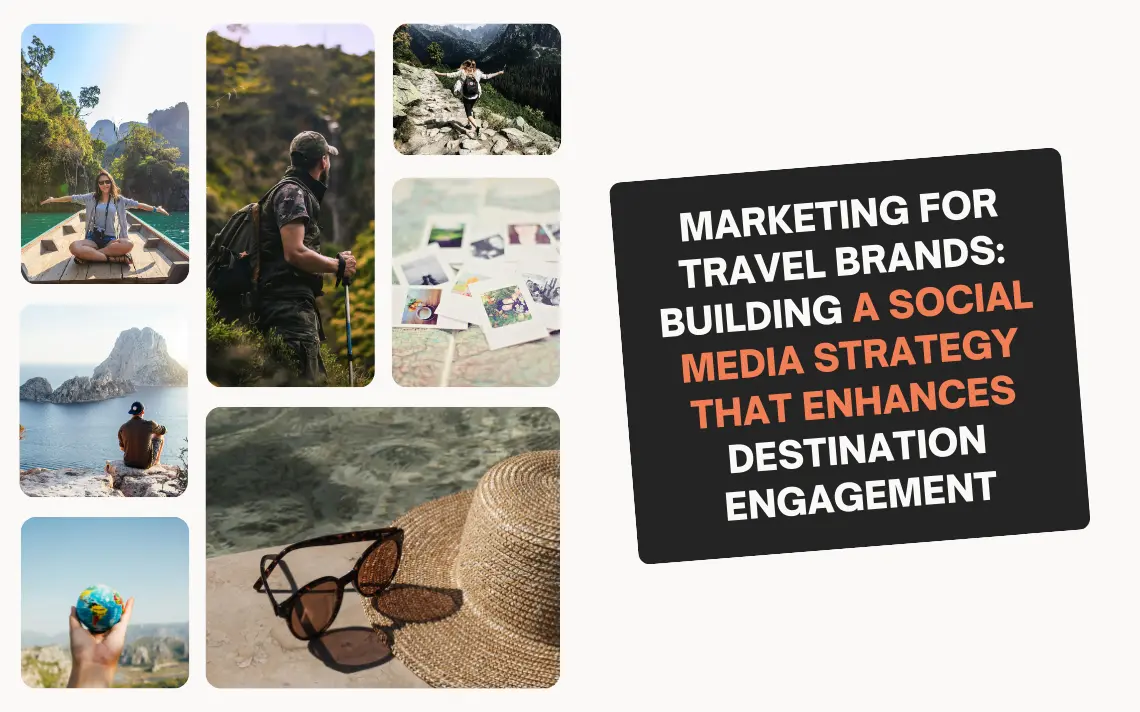
Marketing for Travel Brands: Building a Social Media Strategy That Enhances Destination Engagement
The holiday often starts way before the traveller has arrived at the airport.
In their mind, they are already mentally there. Social platforms like Instagram, TikTok, and YouTube are now the go‑to sources for inspiration, research, and trip planning. For travel brands, this shift represents both a challenge and an opportunity; it’s no longer enough to have a brochure‑style website or post the occasional picture of a landmark.
To succeed in marketing your holiday content, you need to make the user feel like they are actually there already, using immersive experience techniques.
In this article, we’ll explore how travel brands can produce a social media plan that truly immerses the user, making them feel like they’re already there, fostering connections, and ultimately driving bookings.
Why Social Media Is Crucial in Marketing for Travel?
Social media is now where a user will start their research for a destination of choice. A single short‑form video can inspire a trip, while a well‑timed Instagram post can nudge someone from “thinking about it” to “booking it.”
User-generated content is now more important than ever, as someone planning a trip will more likely engage with and feel they can trust this source over traditional advertising. It could be someone you follow on Instagram holiday stories or a creator’s behind‑the‑scenes vlog, these moments make destinations feel authentic and “doable”.
So how can social media help travel brands? It provides greater visibility to both new and repeat travellers. The ability to showcase destinations through immersive storytelling is a key factor and opportunities to build emotional connections that lead to loyalty.
In short, marketing for travel without a strong social presence means missing out on one of the most powerful tools in the industry.
Defining Your Destination Story

Every destination has a story; the challenge is telling it in a way that resonates.
Start by identifying your destination’s unique attributes, things like signature experiences such as wine tours, diving spots and hiking trails. Consider local culture, traditions, natural beauty and architectural landmarks.
From there, create storytelling pillars that guide your content. These could include things like…
- Food & Drink: Showcasing local cuisine through restaurant features or chef interviews.
- Adventure: Capturing outdoor activities like kayaking, cycling or zip-lining.
- Culture & Heritage: Sharing festivals, art and history and relaxation, highlighting beaches, spas or scenic retreats.
The most effective marketing for travel strategies blend these elements with authentic local perspectives – not just glossy, brochure‑style imagery.
Choosing the Right Social Media Platforms
There is sometimes a default with marketers to publish content on the most popular platform at the time e.g. TikTok.
The secret is matching your content to the platforms where your audience is most active, rather than where you think they are. Instagram & TikTok are perfect for short-form, visually appealing content.
Use Instagram Reels or TikTok videos to share quick destination tours, trending challenges or travel tips. Facebook (although likely not the first choice) is still a valuable tool for community engagement, event promotion, and trip-planning discussions in travel groups.
YouTube is ideal for long-form content like travel guides, vlogs or deep dives into cultural attractions. Pinterest is great for inspiring early-stage planners, with visual boards, pins and itineraries.
Remember that consistency is essential, maintain a unified voice, look, and feel across your chosen platforms, allowing your brand to be instantly distinguishable from the competition.
Creating Engaging Destination Content
When it comes to marketing for travel, content must do more than inform; it needs to inspire.
Break down some effective destination content such as; short-form video tours of attractions or neighbourhoods. Traveller-generated content, with permission, that show authentic experiences, behind-the-scenes stories, featuring local people and businesses. Lastly, seasonal countdowns or teasers for festivals, events or peak travel times.
On top of having the right mix of content, storytelling is essential. Your customers want to be able to see themselves in the destinations you’re selling, so appealing to emotion is essential.
When it comes to storytelling in your destination content, some quick tips are:
- Starting with a strong hook in the first few seconds
- Using sensory detail to make viewers feel like they’re there.
- Including a call to action – with the goal of visiting your website, booking an experience, or exploring more content.

Partnering With Influencers and Content Creators
Influencers and content creators can amplify your reach and lend authenticity to your campaigns. This would benefit your travel marketing by bringing an engaged, niche audience and their content feels more like a recommendation than an ad. They can also help showcase your destination through their unique lens.
Best practices for partnerships
Select creators who align with your brand values and target demographic, give creative freedom while ensuring they communicate your key messages. Encourage personal storytelling that highlights their genuine experiences and track results, including engagement, reach, clicks and conversions to measure ROAS (Return on Ad Spend).
Measuring Destination Engagement and Campaign Success
Social media strategies should be data‑driven, not just creative, but start with the people behind the data rather than just statistics. When analysing a campaign there are some key metrics to track; Engagement rate, this is made up of likes, comments, shares and saves. Video completion rate, this is especially important for short-form content.
Follower growth, this is a sign of increasing brand awareness and finally, website clicks demonstrate clear indication of interest turning into action.
Other areas to consider
Use platform analytics, Google Analytics, and UTM tags to measure performance. Regularly review data to refine your approach and double down on what works.
Social media is more than a marketing channel it’s the digital front door to your destination. By telling compelling stories, choosing the right platforms, creating inspiring content, and partnering with the right voices, you can build deeper connections with travellers.
Conslusion
In marketing for travel, the goal is not just to showcase a place but to make people feel they’re already part of the journey. The more you can bring the destination to life online, the more likely they are to book the trip offline.
Now is the time to invest in a destination‑driven social media strategy that transforms inspiration into action and viewers into visitors.
Ready to ‘go places’ with your travel marketing? Send us a message today!





